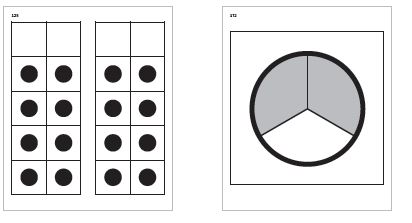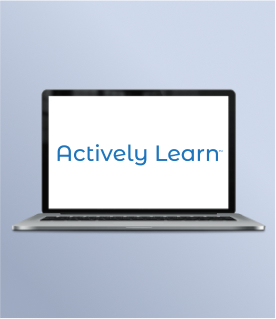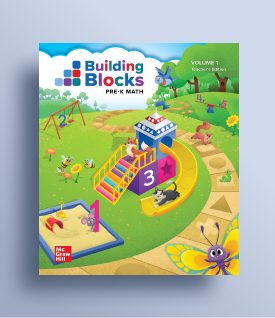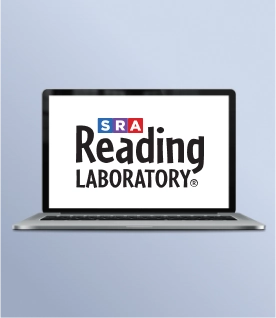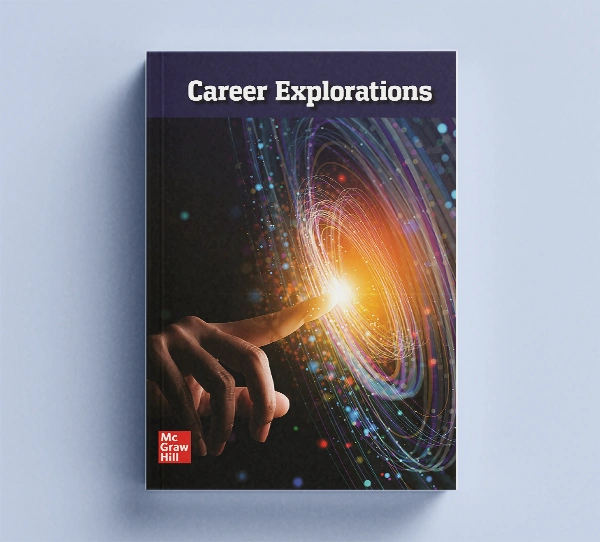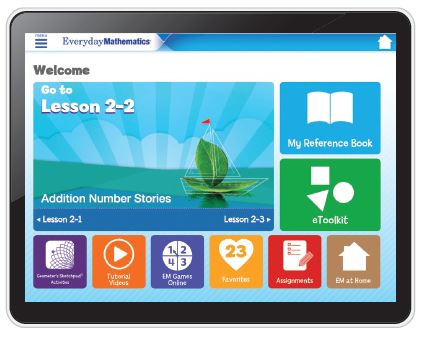My Account Details

Everyday Mathematics K–6 Math Curriculum: Pedagogy & Features
Pedagogy of Everyday Mathematics
Math Dialogue
Talking about mathematics is an essential part of learning mathematics. Opportunities for students to share their reasoning and problem-solving strategies are embedded throughout Everyday Mathematics, making it easy for teachers to facilitate math discussions every day.
I’m seeing a big difference in student performance since we started using Everyday Mathematics. Students have a better understanding of not just what the answer is, but why the answer is what it is.
Jon K., Curriculum Associate for Elementary and Science, Stamford, CT
Productive Struggle
The pacing in Everyday Mathematics gives teachers time to create a classroom culture that values perseverance. Students are given multiple opportunities to think through problems and explain their answers, helping them make connections between concepts and procedures while fostering a positive disposition toward mathematics.
Everyday Mathematics 4 is much heavier in reading and writing. They have fewer problems to solve and a lot more explaining to do about their thinking
Ahlum S., Principal, Sante Fe, NM
Spiraled Instruction
In a true spiral curriculum, both learning and practice are spread over time rather than concentrated in shorter periods. Content is revisited repeatedly over months and across grades. Decades of research into how students learn and how technology can support that learning show that spiraling instruction leads to better long-term mastery of facts, skills, and concepts in almost every discipline, including mathematics.
The spiraling of instruction and practice has been a defining characteristic of Everyday Mathematics since its inception. It is one of the reasons Everyday Mathematics students outscore comparable students on assessments of long-term learning.
Teachers really like that they can work on a standard, then later, the same standard will come up for students to developmentally process and learn.
Judi P., Assistant Coordinator for K-5 Math, Columbia, MO
Game Play
Games are an integral part of Everyday Mathematics. They are an enjoyable way for students to build fluency and develop strategic thinking skills.
More students are enjoying math. They are learning in a fun way instead of just opening up a book and memorizing facts.
Jon K., Curriculum Associate for Elementary and Science, Stamford, CT
Workshop Model
Everyday Mathematics was designed to allow teachers to work with small groups formed according to students’ needs, allowing for support and attention where it is needed. While the teacher meets with small groups, the program provides engaging, meaningful activities for other students in the class.
Everyday Mathematics 4 lessons encourage small-group learning through games, technology and math boxes. And automaticity, fluency, is built into the core through different activities.
Jyll M., Math/Science K–12 Coordinator, Johnston, IA
Growth Mindset
Everyday Mathematics aims equally at developing all students’ mathematical power—their ability to reason, communicate, and solve problems, and fostering productive dispositions in students. This belief that mathematics is worthwhile leads to confidence in one’s own mathematical abilities
Everyday Mathematics really brought to light the process of learning math and not just the end-result...our kids are much better problem solvers than they were before.
Paige B., Instructional Coach, Tulsa, OK
Multi-Tiered Systems of Support (MTSS) and Response to Intervention (RTI)
The fundamental design of Everyday Mathematics is to make differentiation achievable for all teachers who use the program. A differentiated classroom is a rich learning environment that provides students with multiple avenues for acquiring content, making sense of ideas, developing skills, and demonstrating what they know.
The results that we’ve seen in our achievement scores are really strong. Every group within our demographics is reaping the benefits.
Chad S., Assistant to the Superintendent for PreK–8, North Kansas City, KA
Resources for Everyday Mathematics
Teacher Center
You'll never waste time looking for resources because everything you need for every lesson is right where you need it, when you need it, including editable versions of every lesson and activity.
Student Center
Engineered to help each of your students experience confidence and develop positive feelings about math in a digital environment that keeps them engaged and excited about learning.
Assessment & Reporting
Everyday Mathematics includes a complete set of tools and resources to help teachers evaluate the development of each child’s mathematical understanding and skills, while providing actionable data to inform instruction.
Across the board, our math scores are the highest they’ve ever been.
Jason G., Principal, Boston, MA
Daily Formative Assessment
Assessment Check-In provides daily lesson-based assessment opportunities.
Daily Formative Assessment
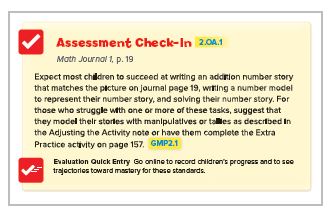
Pre-Unit Assessment
Preview Math Boxes appear in two lessons toward the end of each unit and help you gauge readiness for upcoming content, plan instruction, and choose appropriate differentiation activities.
In addition, data recorded in prior units can provide valuable information to inform instruction in the upcoming unit.
Pre-Unit Assessment
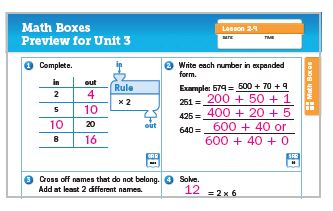
Unit Assessments
Progress Check lessons at the end of each unit provide formal opportunities to assess children’s progress toward mastery of content and process/practice standards that are the focus of the unit.
Unit Assessment
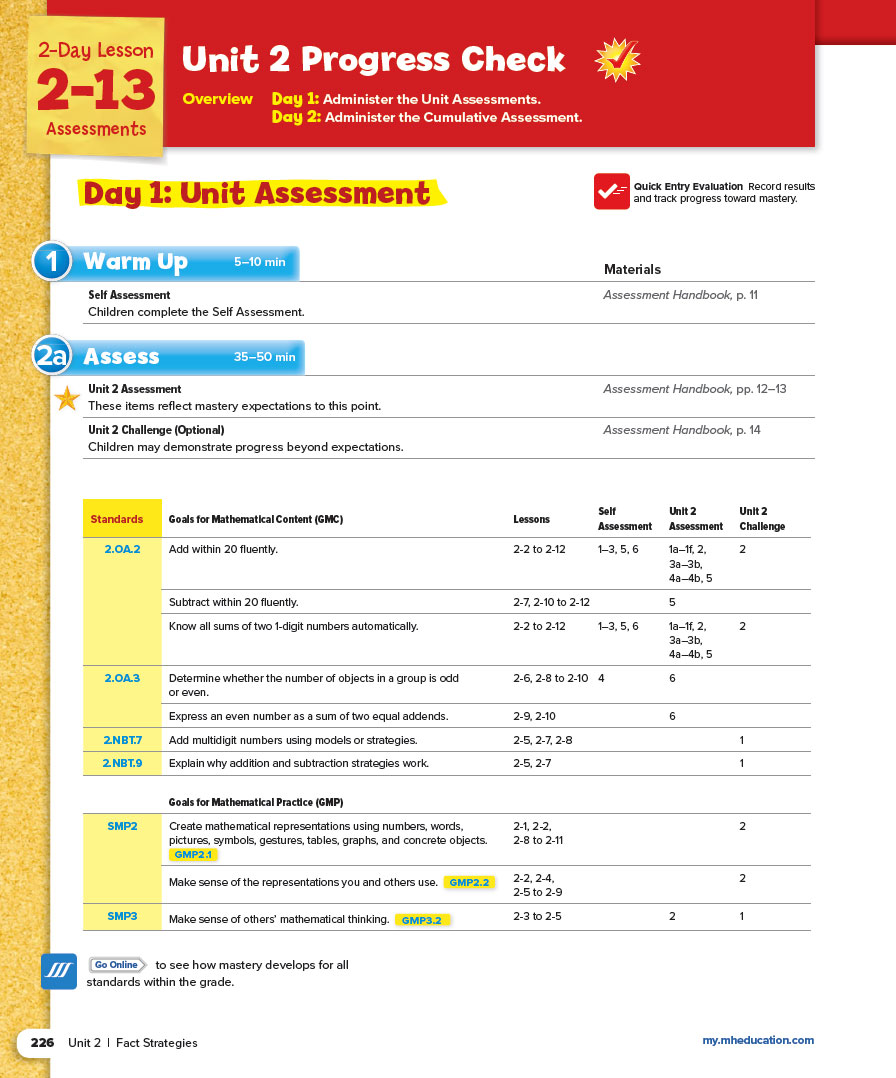
Record
A full suite of tools including rubrics and class checklists are available to help you track your children’s progress.
Record

Report
The Data Dashboard is a responsive reporting tool that delivers actionable information to help you adapt and personalize your instruction and provide feedback to families and administrators.
Unique Resources
Open Response and Reengagement Lessons
Each unit includes a specific lesson that develops students’ ability to think mathematically by explicitly engaging in the mathematical practices to solve a non-routine, rigorous problem.
Open Response and Reengagement Lessons
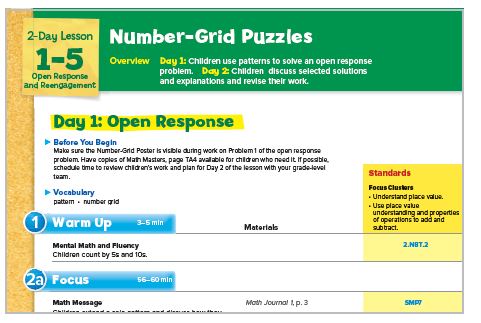
Activity Cards
Activity Cards provide rich tasks for readiness, enrichment, and extra practice and are perfect for flexible stations.
Activity Cards
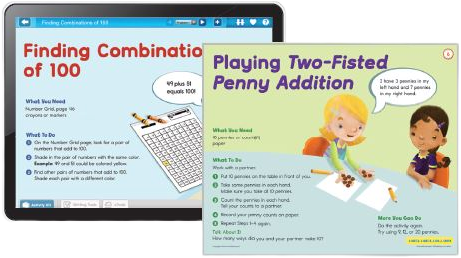
Quick Looks
Quick Look routines develop number sense by allowing children to visually group quantities, break them apart and put them back together. As students encounter various combinations, they develop fact strategies that lead to fact fluency.
Quick Looks
